
Vision
2.7 Transformation Policy |
2.7.1 Integrated Business And IT Policies
For every company, the transition to collaborative systems implies a change process in the long run. This process takes place on two different levels: the transformation of the company and the role IT plays in this transformation.
Transformation of the company
Companies devote a great deal of time and energy to the transformation of their business operations and resources, but also to the possible start of new forms of business. In this process, companies make deliberate choices for IT applications and the IT infrastructure to help them realise these transformations.
Growing role of IT:
The role of IT in a company increases because IT integrates into an IT infrastructure involving the entire company including the connections with other companies and private individuals. The IT applications that use this infrastructure gradually integrate, resulting in a complete collaborative system.
The gap
Companies are confronted with a double change. There is a concurrent transformation of the business operations and the application of IT. Employees have to learn to handle the new IT and they must discover the possibilities for its application. A great deal is also demanded of their creativity in finding good possibilities to transform the business operations by means of IT.
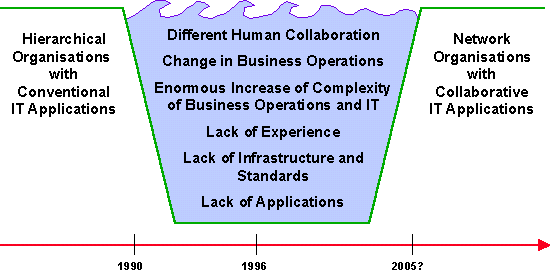
Figure 2.5 The gap between the present information systems and the new collaborative systems. The transition between the present information systems and the future collaborative systems is so far-reaching that we can speak of a 'gap' that must be bridged by the company. This gap is caused amongst other things by:
- large changes in the business operations;
- great changes in the inter-human relations;
- a strong increase in the complexity of both business operations and IT;
- still lacking parts in the IT infrastructure;
- still lacking components of the required generic and specific IT applications;
- still lacking experience of the people involved.
In order to bridge the gap, the company should have a long-term policy. This policy will on the one hand focus on the transformation of the business operations and on the other hand on the gradual implementation of new IT, parallel to the integration of new and existing IT into one integral platform.
This requires an integrated business and IT policy in which the company not only bridges the gap but also and at the same time implements the desired transformations in the business operations and the configuration of resources and goes through the required IT learning process.
In the rest of this section we will go into a number of aspects of an integrated business and IT policy.
The framework for business and IT policy
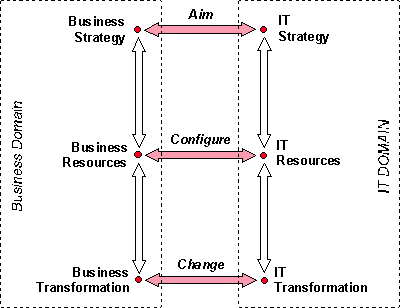
To apply an integrated business and IT policy we must have a frame of reference in which we can place the various aspects of the policy and the changes to be implemented. In this frame of reference, the relationship between business and IT is systematically analysed. We call this the distinction between the business domain and the IT domain. With this division in domains, the coherence between IT problems and business problems can be made clear. This is laid down in the framework as represented in figure 2.8.
Within each domain, a distinction is being made between strategy, resources and transformations.
In the business strategy, choices are involved with respect to the products and services, the relations with customers and suppliers, the competition or co-operation with other companies and the focus on the core activities or the core competences of the company.
Business resources concern the configuration of human and other resources for the new business operations, based on the formulated strategy. This concerns amongst other things choices with respect to the future business operations and the required staff and resources. IT resources and the IT staff are excluded.
Business change is the process to arrive at the new configuration of resources and the new business operations to realise a business transformation.
IT strategy concerns the choices with respect to products, concepts and knowledge in the field of IT, that need to be available within the company. This is of course closely related to the business strategy and is intended to facilitate new or improved products, services or business processes.
The IT resources can be subdivided into the IT infrastructure, the IT applications and the IT organisation. The IT infrastructure includes the hardware and the 'hard' infrastructural software necessary to develop, manage and run the applications. The IT applications include the formal applications, aimed at specific business processes, and the generic applications, aimed at generic tasks. The IT organisation consists of the business operations necessary for the development, configuration, management and support of the IT infrastructure and the IT applications, including the necessary IT staff and tools. IT transformation concerns the process of arriving at a new or innovated configuration of the IT infrastructure, IT applications and IT organisation.
Looking at the process of formulating a policy, we notice three subprocesses in the framework:
- Aim - this refers to the definition of a strategy and the goals with respect to business operations and application of IT;
- Configure - this refers to the configuration of the resources for the business operations, with specific attention for the IT applications, IT infrastructure and IT organisation;
- Change - this refers to the process of change that must be gone through to arrive at the new business operations and configuration of resources.
The strategy gives direction to the organisation and the transformation of the company. The human and other resources determine a company's capacity to change. The strategy determines the course of the changes and the configuration of resources determines the feasibility of the changes. The strategy will therefore have to concentrate above all on the reinforcement of the company's capacity to change. This can mean that people with the right knowledge and skills will have to be recruited first, and advanced resources (such as IT) will have to be purchased, before the desired change processes can take place. In other words: the company first enhances its core competences to be able to implement the desired transformations. This way, the strategy determines the intent of the company, while the configuration of the resources determines its ability.
In the framework there is a special interaction between the business domain and the IT domain, in which IT and business operations can influence each other to an important degree.
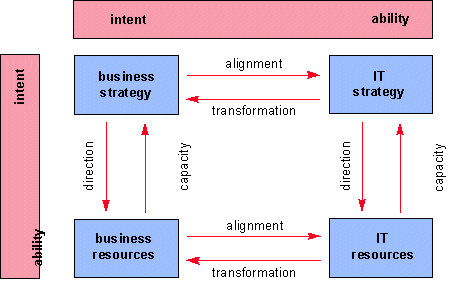
Figure 2.7 Interaction in framework.
Business operations and IT affect each other in the following way:
Alignment
When the company actively applies the IT domain for the realisation of the business goals, we call this alignment of the IT domain to the business domain. A company for example purchases new IT to facilitate the desired form of business operation.
Transformation
If the company deliberately reinforces the IT domain in order to provide the business domain with many new possibilities for development, we call this transformation of the business domain by means of IT.
The business domain and the IT domain show the same relationship between 'intent' and 'ability' as strategy and configuration of resources. The business domain determines a company's intent in terms of IT support, while the technology as a resource determines the ability of the company. If the ability does not correspond with the intent, a change process will be initiated to align the configuration of resources and the business operations. This change process itself, which can take place in either the business domain or the IT domain, is the third layer in the framework.
Internal versus external focus
Within the framework as we described it, we also have to take into account the distinction between internal and external area of attention, besides the division in strategy, resources and transformation.
Externally, the company looks at the developments and opportunities in the environment. These could lead to changes. Externally, the attention is focused on customers, the competition, partners and suppliers, and on relevant social developments. Internally, the company mainly focuses on the configuration of human and other resources that form the core competences that allow for changes with respect to services, products and business operations.
With respect to business operations, the company internally focuses on the possibilities to change the business processes by which the products and services are realised for the environment. External business operations concern the processes involved with the relationships with the environment, for instance with customers and suppliers, and the use of services and resources provided by third parties. This also concerns external installations of third parties, for instance a telecommunication network.
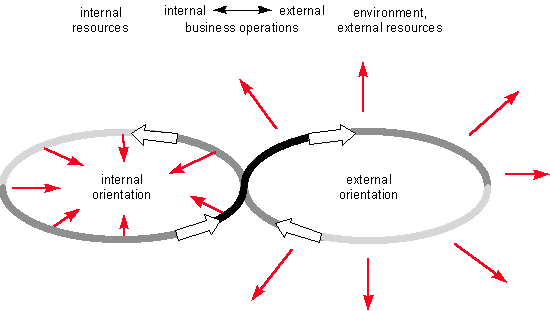
Figure 2.8 The lemniscate of policy making. In the formulation of the strategy, there is an interaction between the internal and external areas of attention. If the focus is on the environment, the internal organisation is implicitly taken into account, and vice versa. In the course of time, internal and external focus alternate constantly. This alternation between internal and external can be shown in a lemniscate.
A company can first focus on the environment to see which developments are taking place, and derive the changes that are necessary in the own organisation. The other way around, a company can first make an internal inventory of the core competences and then lookaround to determine the opportunities and possibilities it can utilise, for example by first innovatively determining the products or services it can offer the environment, and then look for potential customers.
With respect to IT there can also be an interaction between internal and external focus. Externally, the company investigates the possibilities offered by existing and new IT, and the way in which IT is applied in other companies. This provides a handle for the application of IT in the own organisation. This development of IT is aimed at the desired transformation of the company. The company will - more quickly, perhaps - go through the learning process with certain IT in order to accumulate sufficient experience and IT resources.
At the turning point in the lemniscate the company always keeps the balance between external opportunities and threats and the internal strengths and weaknesses of the own organisation. This prevents the internal organisation from dominating the formulation of the policy too much, which would prevent the company from responding to external developments. It also prevents an undesirable dominance of external focus, in which the alignment to the environment and the anticipation of the wishes of customers takes its toll on the attention for the development of the own, internal organisation.
2.7.2 Approaches To Change
In the previous section, we described a number of important aspects of an integrated business and IT policy. A company then formulates a strategy for its business operation and its IT. This strategy determines the future configuration of business operations and IT.
In this section, we indicate how the company can subsequently set out a change trajectory to implement the transformation in the company and in the IT. This trajectory on the one hand consists of steps aimed at the transformation of the company, and on the other hand of steps in which the IT infrastructure and applications are gradually expanded.
Uncertain factors in transformations of business and IT
There are three uncertain factors companies face in the transformation process:
Uncertainty with respect to business operations
An uncertain factor in many companies is the development of the business operations. The increasing changes in society, in the business sectors and in the markets force companies to adapt and respond quickly. The development of new products and services, and the design of adequate, flexible business processes, purchasing channels and sales channels are therefore becoming increasingly important.
Uncertainty with respect to IT infrastructure
Since IT is still developing, the IT infrastructures are also uncertain. This does not apply so much to the specific IT infrastructure that supports the present, stand-alone applications. It mainly concerns the future infrastructure of the entire computer network, that will emerge as a result of the Digital Highway. The technological standards for hardware and networks are often still under development. This is a great source of uncertainty.
Uncertainty with respect to IT applications
The previous two aspects of uncertainty cause a double uncertainty with respect to the development of IT applications. It is not always known which business operations the applications are to support and it is unknown which IT infrastructure they will be using. The application architectures are also still being developed. There are no generally accepted standards with respect to client/server architectures and in particular object-oriented architectures.
Choosing an approach to change
The uncertainty with respect to business operations, IT applications and IT infrastructure can cause companies great problems. If the company decides in favour of drastic business and IT transformations, the company management faces the choice for an approach to be used. This choice is in fact between the 'blueprint' approach, the 'growth' approach or a hybrid of these, the 'development plan' approach.
The blueprint approach
The blueprint approach is based on the assumption that an organisation can be 'moulded'. The new business operations, the IT applications to be developed and the configuration of human and other resources can be accurately described beforehand in documents and models, the 'blueprint' of the future organisation. The approach allows for the design and realisation of transformations of which the results can be formally described in advance. This blueprint approach is generally applied in the design and construction of conventional information systems. The development process of an information system is strictly formalised in this approach. The IT focus dominates. The starting point is the current or a desired new situation with respect to business operations. Possible transformations of the business operations and business processes are usually considered to be tasks of the company itself. These are therefore not included in the development path. The deliberate introduction of new IT to facilitate a certain transformation is a rare practice. The blueprint approach prefers the use of proven technology.
The blueprint approach uses a separate development organisation that prepares the transformation and a user organisation that undergoes the transformation. The development organisation handles the application development and the purchasing of resources. The transformation is then implemented through integration of the infrastructure and the applications in the business operations. The user organisation switches to the new infrastructure, applications and procedures all at once.
An implicit assumption in the blueprint approach is often that the new or existing business operations will remain unchanged for a long period. The current dynamic external environment is the reason that companies often have to quickly adapt their business operations. So quickly, in fact, that the blueprint on which the transformation is based, is already outdated before the information system and the new business operations could be realised. The dynamics of the environment create a quicksand foundation underneath the blueprint, whereas the blueprint was in fact the basis for planning the change activities. The continuous adaptation of the plans could gradually start to form an obstruction, whereas these plans were in fact meant to provide a footing for the long-term system development. As a result, the transformation often remains incomplete, or does not happen at all.
The growth approach
In dynamic environments the growth approach is a more logical choice. This approach aims at implementing a change in the business operations through providing the right resources and through training or recruiting staff. The actual change is left to the self-organisation of the employees involved. The strategy points out the direction of the change. An important basis for acquiring the desired flexibility in this approach is formed by making available (non-specific) generic, infrastructural facilities. With the support of such an infrastructure, the company is able to adapt its business operations relatively fast and still introduce new applications and change existing ones. A simple example is providing a PC on which a number of software packages are installed, with which the user can configure his own, personal applications. Such 'informal' PC applications are of a completely different nature than the formal applications on the conventional central information systems. A word processor on the PC is an example of a generic 'informal' application. The user can use it to create his own documents and pictures. This is a much more flexible way of working than the on-line applications on a central system with specific, formal applications, for these force the user to retrieve and edit data in a specific way. The growth approach therefore leaves much room for the personal responsibility of employees.
There are, however, also a number of risks to the use of a growth approach for the application of IT:
- there can be a proliferation of all kinds of stand-alone applications and hardware;
- after the phase of island automation the stand-alone applications will turn out to be unfit for integration into one network system.
A result may be that in the long run there will be no large IT platform that facilitates large transformations of the company by means of collaborative applications.
The development plan approach
The choice between blueprint and growth is a difficult one with large transformations. With the blueprint approach, the transformation can often not be realised. A lack of the flexibility necessary for interim changes and a lack of room for creativity of the designers and users, are the causes for the fact that the result often does not meet the initial expectations. The growth approach does not offer a solution either. There is often too much room for flexibility and personal creativity, which stands in the way of a coherent result in the long run. A well-chosen hybrid form of the two approaches provides an answer to the dilemma: the development plan approach. This approach is possible as soon as a company is able to form a reasonable idea of its future.
The development plan approach can be used to realise the necessary changes in the business operations, including the use of IT, in case of a long, complex and large operation. So large, that the transformation cannot be realised in one step, but only in a series of small steps. An incremental form of transformation is chosen. In the development plan, the outlines are given for the ideal situation in the long run.
A development plan covers the following aspects:
- the future business operations;
- the necessary transformation of the current business operations;
the order and coherence of the incremental transformation;
- the kind of IT applications required;
- the nature of the necessary infrastructure.
A development plan allows for some control in times of rapid changes in a dynamic environment, in leading the change processes in the course of change the company wishes to take. The desired situation is roughly described on the basis of the business goals, without defining a time span.
The incremental changes that are elaborated and realised, do not provide ideal situations in the long run, but they are feasible situations in the short term, that all contribute to realising the long-term goals. Each feasible situation is tangible and can be realised within an acceptable time span. The situations are defined in terms of given preconditions, starting points and limitations. The feasibility in terms of quantity, quality and time is tested for each step in the change process.
One step at a time
For each step in the change process a choice is made for either 'blueprint' or 'growth', or for a hybrid form, so-called 'iterative development'.
Blueprint means: formally designing and realising the transformation of the business processes, the IT applications and the IT infrastructure in advance.
Growth means: providing the right people and resources (including IT) to facilitate a transformation of certain business processes.
Iterative development means: building applications in a number of iterative steps in consultation with the user, including the implementation of the changes in the business processes. This works well in situations in which the application and the corresponding business process cannot be completely described in advance. Iterative development is also a good way to test and introduce new IT infrastructure.
Each step can be executed like a project. As a result of the gradual, step-by-step realisation, the necessary room remains available to respond to unforeseen changes. This makes it possible to not only make interim adaptations to the policy and the development plan, but to also execute the detailed project plans step by step, with the necessary budgets, people and resources.
Software building blocks
Recently, a new trend has developed in application building: the construction of IT applications by means of software components. This is possible through the use of object orientation and corresponding application architectures. This orientation provides a parallel with the manufacturing of so-called pre-fabricated houses. System developers assemble applications from a set of 'building blocks". By combining building blocks, new applications can be constructed relatively fast - often on a situational basis. This makes it relatively easy to meet the need for certain IT applications.
As a result, the strict separation between blueprint and growth becomes vaguer. The approach is aimed at both creating company-specific software building blocks and at purchasing generic software building blocks from software vendors. The more specific and generic building blocks a company has, the faster can applications be constructed. The specific custom applications are easy to make, and easy to adapt - since they are flexibly made out of building blocks. They will therefore more and more be developed and changed in an iterative way. Only new building blocks are still created from scratch. The other applications can be developed iteratively in consultation with the user, or they will grow as users construct their own applications from the available building blocks.
More and more applications will be a mixture between generic and specific, since they will consist of both types of components.
A development plan helps to be able to determine in advance which software building blocks will be needed in the applications to be realised. Since the use of software building blocks enhances the flexibility of applications, they are also important resources to be able to use the development plan approach. In the realisation of large transformations it is much easier to change existing applications or applications that are still being developed.
Development plan versus blueprint
In figure 2.9 the differences between the development plan approach and the conventional blueprint approach are summarised.
In the conventional blueprint approach, the development process for an information system is highly formalised. The present or desired situation is taken as the starting point. The classic development starts with the formulation of the information strategy, followed by the definition of the architecture of the information system and the detailed description of the IT applications (grouped into subsystems). Architecture and detailed descriptions form the blueprint for the realisation of the IT applications and the IT infrastructure. At the most, the building phase can be divided into subprojects that focus on the IT applications per subsystem. This results in a large, rather inflexible information system. The whole working order is more or less linear. The development path must in fact be gone through from the beginning to the end. Plans or detailed descriptions can hardly be reversed. If at some stage it turns out that mistakes were made at an earlier stage, or that the principles of for example business operations are radically different, the development is in dire straits.
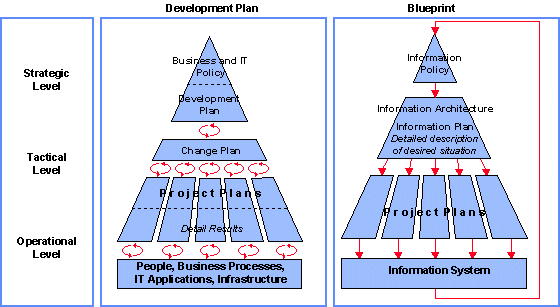
Figure 2.9 Development plan versus blueprint. The development plan approach corresponds well to the framework for an integrated business and IT policy, described in section 2.7.1. The combined business and IT strategy is the starting point for the definition of a development plan. Thus, the realisation of the proper configuration of the business operations and IT can be led in the right direction. Strategy and development plan form the basis for more detailed plans on a tactical level. The company draws up an incremental plan for the changes. The various steps are gone through in the right order in the form of projects. For each step the appropriate approach (blueprint, growth, or iterative) is chosen, based on the situation and the right people and resources are assembled to allow for the implementation of the changes. Changes in the business operations can be executed by the employees themselves. This particularly applies to the growth approach, after the right infrastructure has become available. For more drastic steps, a separate project organisation must be set up, with the task of realising this step in the transformation.
Each change project designs and realises its own portion of change in the business operations and the IT. All processes of policy making, planning and change at the various levels take place on a constant basis and with a continuous interaction. This way, the change process can be controlled and adapted if the situation changes.
Development plans and collaborative systems
The development plan approach does not result in one large information system, but in a business operation in the form of a flexible network of people, resources and business processes. This business operation is supported by a flexible network of IT applications consisting of specific and generic software components. These applications are in turn supported by an infrastructure in the form of a flexible computer network. In short, a collaborative system of people and resources.
The development plan therefore goes very well with collaborative systems. The approach combines the step-by-step construction of specific, formal applications with the growth of generic, informal applications. In uncertain situations, the iterative approach is used to realise the right applications and infrastructure. At the same time, the IT infrastructure is allowed to grow to such an extent that it offers sufficient room for all applications. The development plan has to guarantee that the future integration into one network of hardware and collaborative applications remains possible. This way, the company deliberately and gradually goes through the learning IT process. It is also prevented that investments are made into all kinds of applications and hardware that turn out not to fit in the network system.
The eventual result is one large IT platform for the entire company or interorganisation. By means of collaborative systems on this platform, large transformations of the entire company are possible, for example logistics chain integration or new forms of front-office and extended office in administrative environments.